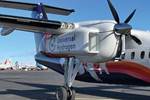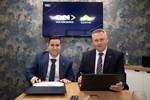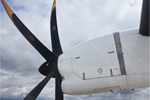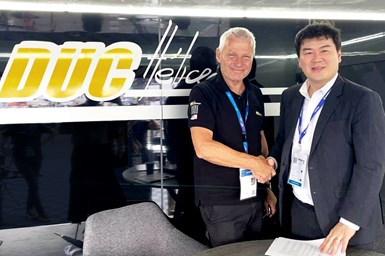Plana, DUC Hélices Propellers to develop propellers for AAM
High-performance, low-noise, and eco-friendly composite propulsion systems will be designed, produced, tested and certified for the CP-01 hybrid eVTOL aircraft.
Hybrid electric vertical takeoff and landing (HeVTOL) developer Plana (Gyeonggi-do, South Korea) and carbon fiber composite propeller and rotor manufacturer DUC Hélices Propellers (Frontenas, France), have announced a partnership to design and produce high-performance, low-noise and efficient propulsion systems for Plana’s composites-intensive CP-01 aircraft (read “Plana targets full-scale, hybrid-electric eVTOL prototype by 2025”). The goal of the partnership is to integrate the expertise of both companies in the development of advanced air mobility (AAM) aircraft, collaborating over the entire process of propeller design, production, testing and certification.
DUC Hélices Propellers CEO Duqueine Vincent (left) and Plana CEO Braden J. Kim (right) sign for the collaboration at the 2023 Paris Air Show. Photo Credit: Plana
Recently, DUC Hélices Propellers signed a deal to provide its products to Eve Air Mobility (São José dos Campos), a Brazilian VTOL developer. DUC boasts more than 25 years of experience and expertise in the analysis, design, development, manufacture and maintenance of propellers, rotors, fans and other carbon fiber composite aviation accessories, with experience gained through several aviation programs.
This marks the second partnership announced by Plana at this year’s Paris Air Show, marked by the signing ceremony by Plana CEO Braden J. Kim and DUC Hélices Propellers CEO Duqueine Vincent.
“Propulsion is crucial to the success of AAM,” says Kim. “We are pleased to partner with leading suppliers like DUC Hélices Propellers to create innovative solutions. I expect this partnership to accelerate the flight of the aircraft we are developing.”
Watch the video below to learn more about DUC’s production of its carbon fiber propellers.
Related Content
-
The lessons behind OceanGate
Carbon fiber composites faced much criticism in the wake of the OceanGate submersible accident. CW’s publisher Jeff Sloan explains that it’s not that simple.
-
Plant tour: Teijin Carbon America Inc., Greenwood, S.C., U.S.
In 2018, Teijin broke ground on a facility that is reportedly the largest capacity carbon fiber line currently in existence. The line has been fully functional for nearly two years and has plenty of room for expansion.
-
Cryo-compressed hydrogen, the best solution for storage and refueling stations?
Cryomotive’s CRYOGAS solution claims the highest storage density, lowest refueling cost and widest operating range without H2 losses while using one-fifth the carbon fiber required in compressed gas tanks.


















